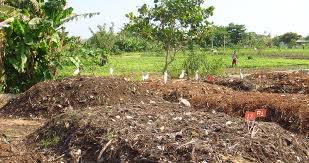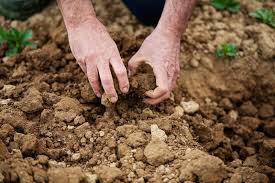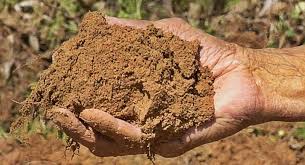In this present article, the various types of soil available for plant growth and how to improve them for maximum production shall be discussed.
Concept and Meaning of Soil in Agriculture
Soil is unconsolidated material derived from rock weathering and which has been acted upon by climate and vegetation.
The soil consists of the following:
i. mineral materials, e.g. sand, clay, silt, gravel, etc.
ii. organic materials which are made up of plants and animals
iii. water
iv. air
Soil Classes and Their Agricultural Importance
Soil materials are classified according to the size of the individual particles that make up the major proportion of the sample. The international scale for naming rock or soil particles is shown on the following page.
This is also called the Alterberg system. The proportion of the various sizes in a soil sample has important effects on the soil’s physical and chemical properties. Agricultural soils are mixtures of separates in varying proportions together with organic matter, air and water.
They are classified according to the separate that has the greatest influence on the characteristics of the sample.
For example, if coarse particles predominate, the properties of the soil will be more of sands, and where fine particles are in greater number, characteristics of heavy soils will be more evident.
The classes are:
1. Loam: Loam is soil made up of separates in such a way that the characteristics of no one separate dominate those of the others. It is neither sticky as clay, nor floury as silt, nor gritty as sand.
It offers easy passage to water and at the same time retains enough water for use by the plants. It is easily worked into good tilth which enables plant roots to penetrate easily.
2. Sandy loam: This is the name given to a sample in which the properties of the sand fraction predominate over those of clay and silt.
3. Clay loam: This is the name given to the soil when the properties of clay predominate.
4. Silt loam: This is the name for a sample that contains large quantities of silt, thus showing the velvety characteristic of silt. Silt loam has neither the cohesive properties of clay nor the grittiness of sand. Because it lacks the cohesiveness of clay and clay loam, it is easier to keep it in good tilth.
5. Silt: This is soil material that contains about 80% or more of silt and less than 12% of clay. The velvety or flour-like properties are predominant in silt.
6. Sandy soils: These are soil materials that contain 85% or more of sand. The percentage of silt plus clay shall not exceed 15%. The gritty properties of sand predominate.
7. A generalised grouping of soils: Sometimes soils are grouped into coarse-textured, medium-textured and fine-textured soils. Under coarse-textured soils are sandy soils and sandy loams.
Loams and silt loams are medium-textured soils. Clay loams, silty clay loams and clays are fine-textured soils often called heavy soils, while coarse-textured soils are referred to as light soils.
Usually, heavy soils retain much moisture and sometimes are water-logged. Light soils are porous.
Read Also: How to Care for Thinleaf Cottonsedge (Eriophorum Viridicarinatum)
Soil Formation and Its Agricultural Significance

The factors affecting soil formation are:
1. Parent Material
The earth’s crust is composed of elements. The major ones in their order of predominance are oxygen, silicon, aluminum, iron, calcium, sodium, potassium, magnesium, titanium, hydrogen, carbon, phosphorus and sulphur.
These elements vary in the proportion in which they exist in different parts of the crust. For example, while calcium exists in commercial quantities and is mined in some places, the quantity in some areas is not sufficient to promote plant growth.
These elements combine in various proportions to form the rocks of the earth which are the parent materials. Parent materials differ in structure, composition and rate of decomposition. These differences are due to the difference in the proportions and type of elements that form the parent material.
For example, oxygen combines with iron to form oxides of iron. It combines with silicon to form the oxide of silicon. On the other hand, metals form hydroxides which may combine with carbon dioxide to form carbonates.
Elements like Ca, Mg, Na, Al, Fe, and K form silicate minerals with various types of silicic acid like metasilicic, polysilicic and orthosilicic.
The parent materials disintegrate to form the soils whose properties will be greatly influenced by the properties of the parent material.
2. Topography
This involves the position of the land, whether the land is on a hill or a slope or in a valley, and the degree of exposure of the surface to wind, light and rainfall.
Topography affects run-off. Much soil may not form on a steep slope as the soil is subject to run-off as well as wind erosion. On the other hand, there is likely to be rapid accumulation of soil in a valley as rain, wind and running water will carry soil from other places and heap it in the valley.
3. Climate
Climatic factors like rainfall, temperature changes and wind are of major importance here. Rainfall facilitates the washing down of the products of disintegration deeper into the soil. Due to run-off in some places, the amount of soil formed will continue to decrease.
Heat aids chemical reaction and the greater the heat, the faster the reaction. The soil-forming process involves some chemical disintegration of minerals and the greater the intensity of heat, the greater the amount of soil formed.
Wind carries away soil particles so that the greater the velocity of the wind, the greater will be the amount of particles carried away.
4. Biotic Factor / Organisms
This means plants and animals whether they are microbes or macrobes. Here, man is even included. Organisms help in one way or the other in the disintegration of rocks.
Micro-organisms may secrete substances that help the chemical reaction in the soil; the roots of plants, on finding their way into small cracks in the rocks, aid disintegration.
The larger animals, through their activities on the surface of the rocks, help to break the rocks into particles. It must be remembered that when any organism dies, the remains of the body will eventually go to form part of the soil.
5. Time Factor
This means the duration of the soil-forming process. The longer the time the soil-forming process lasts, the greater the quantity of soil that will be formed.
Soil Texture and Its Role in Crop Production

Texture refers to the proportion or percentage of the different sized particles that make up the sample.
The following methods are adopted in determining the texture of the soil:
1. By Feel: The texture can roughly be determined by its feel. When rubbed between the fingers, a coarse or gritty feel indicates a sandy texture while a smooth or floury feel denotes a silt texture. When wet, clay has a sticky feel.
2. Moulding: This is a field method of determining texture. The sample is moistened and kneaded thoroughly. It is formed into a ribbon. If the ribbon can be formed into a circle, the sample is clay.
If it can bend into a “U”, it is a clay-loam. But if the ribbon breaks when bent, the texture is loam. If it does not form a ribbon at all, then it is a sandy texture.
3. Sedimentation and Sieve Method: This is usually a laboratory method. The sieve is used to separate the sand fraction, but it cannot be made fine enough to separate silt and clay.
Sedimentation uses the principle that when different sized particles are shaken up in water, they separate out the largest particles falling to the bottom first, followed by the smaller particles, and the smallest particles are left on top.
Land-Use and Land Tenure System in Nigeria
Land serves as a crucial asset in the agricultural sector. It provides the foundation for all farming activities, including crop production, animal husbandry, forestry, and fisheries.
In Nigeria, land use and tenure systems significantly influence agricultural productivity, development planning, and resource management.
Understanding how land is used and owned in Nigeria is important for efficient agricultural development and rural transformation.
Meaning of Land-Use
Land use refers to the way land is utilized by humans for various purposes. It describes how different portions of land are allocated for specific activities such as agriculture, industry, residential, transportation, recreation, and conservation.
In agriculture, land use involves all farming operations including cultivation, grazing, and irrigation. It determines the pattern of farming and influences sustainability and environmental management.
Types of Land-Use in Nigeria
1. Agricultural Land-Use: This is land used for growing crops and raising livestock. It includes arable land, pastures, plantations, and fish ponds.
2. Industrial Land-Use: Land allocated for factories, manufacturing plants, and processing industries.
3. Residential Land-Use: Land used for building homes, apartments, and other dwellings.
4. Commercial Land-Use: Land designated for markets, shops, offices, and business activities.
5. Recreational Land-Use: Areas set aside for leisure activities such as parks, sports grounds, and tourism centers.
6. Transportation Land-Use: Land used for roads, railways, airports, and seaports that support the movement of people and goods.
7. Institutional Land-Use: This includes land used for schools, hospitals, religious centers, and government institutions.
8. Conservation Land-Use: Land preserved for forests, wildlife, and natural resources to protect biodiversity and the environment.
Read Also: The Morphology of Grasses: Morphological Characteristics of Grasses
Meaning of Land Tenure System

A land tenure system refers to the arrangement through which land is owned, accessed, controlled, and transferred within a society. It defines the rights and responsibilities of individuals or groups concerning land. In Nigeria, different land tenure systems exist due to the diversity of customs, legal frameworks, and government policies.
Types of Land Tenure System in Nigeria
1. Communal Land Tenure: Land is owned collectively by a community, and individuals use it with the approval of community leaders.
2. Freehold Tenure: Land ownership is permanent, and the owner has legal rights to sell, lease, or bequeath the land.
3. Leasehold Tenure: Land is rented for a specific period under agreed conditions between the lessor and the lessee.
4. Inheritance Tenure: Land rights are transferred from parents to their children or relatives after death, often based on customs.
5. Tenant-at-Will: A temporary arrangement where land is granted to a tenant by the owner, who may revoke it at any time without notice.
6. Gift Tenure: Land is given voluntarily to an individual without payment and can be withdrawn at the donor’s discretion.
Advantages of Land Tenure System
1. Encourages investment in land development: Clear ownership encourages farmers to improve and invest in the land.
2. Enhances credit accessibility: Legal ownership allows land to be used as collateral for loans.
3. Promotes efficient land use: Secure tenure motivates optimal use of land resources.
4. Ensures land security: Reduces land disputes and provides stability for landholders.
5. Supports inheritance planning: Land can be passed on to heirs, promoting continuity in farming operations.
Disadvantages of Land Tenure System
1. Limits access to land: Traditional or communal systems may restrict non-members from acquiring land.
2. Causes land fragmentation: Inheritance can lead to subdivision of land into uneconomic units.
3. Increases land disputes: Unclear boundaries or overlapping claims can result in conflicts.
4. Slows down mechanization: Small land sizes discourage the use of modern equipment.
5. Discourages land improvements: Uncertain tenure systems may limit long-term investments in the land.
Land Use Decree of 1978 (Land Use Act)
The Land Use Decree of 1978, now known as the Land Use Act, was enacted to regulate land ownership and simplify land administration in Nigeria.
The law transferred all land in each state to the government, which holds it in trust for the people. It aims to ensure equitable access to land and prevent land speculation.
Key Provisions of the Land Use Act
1. Vests land ownership in the government: All land is under the control of the state governor, who grants rights of occupancy.
2. Introduces Certificate of Occupancy (C of O): Legal document given to individuals or organizations to use land for a specified purpose and period.
3. Prohibits land sales without government approval: Prevents illegal transactions and ensures proper documentation.
4. Encourages planned development: Land allocation is guided by zoning and development plans.
5. Facilitates compensation for acquired land: Landowners are compensated if the government acquires land for public purposes.
Do you have any questions, suggestions, or contributions? If so, please feel free to use the comment box below to share your thoughts. We also encourage you to kindly share this information with others who might benefit from it. Since we can’t reach everyone at once, we truly appreciate your help in spreading the word. Thank you so much for your support and for sharing!

